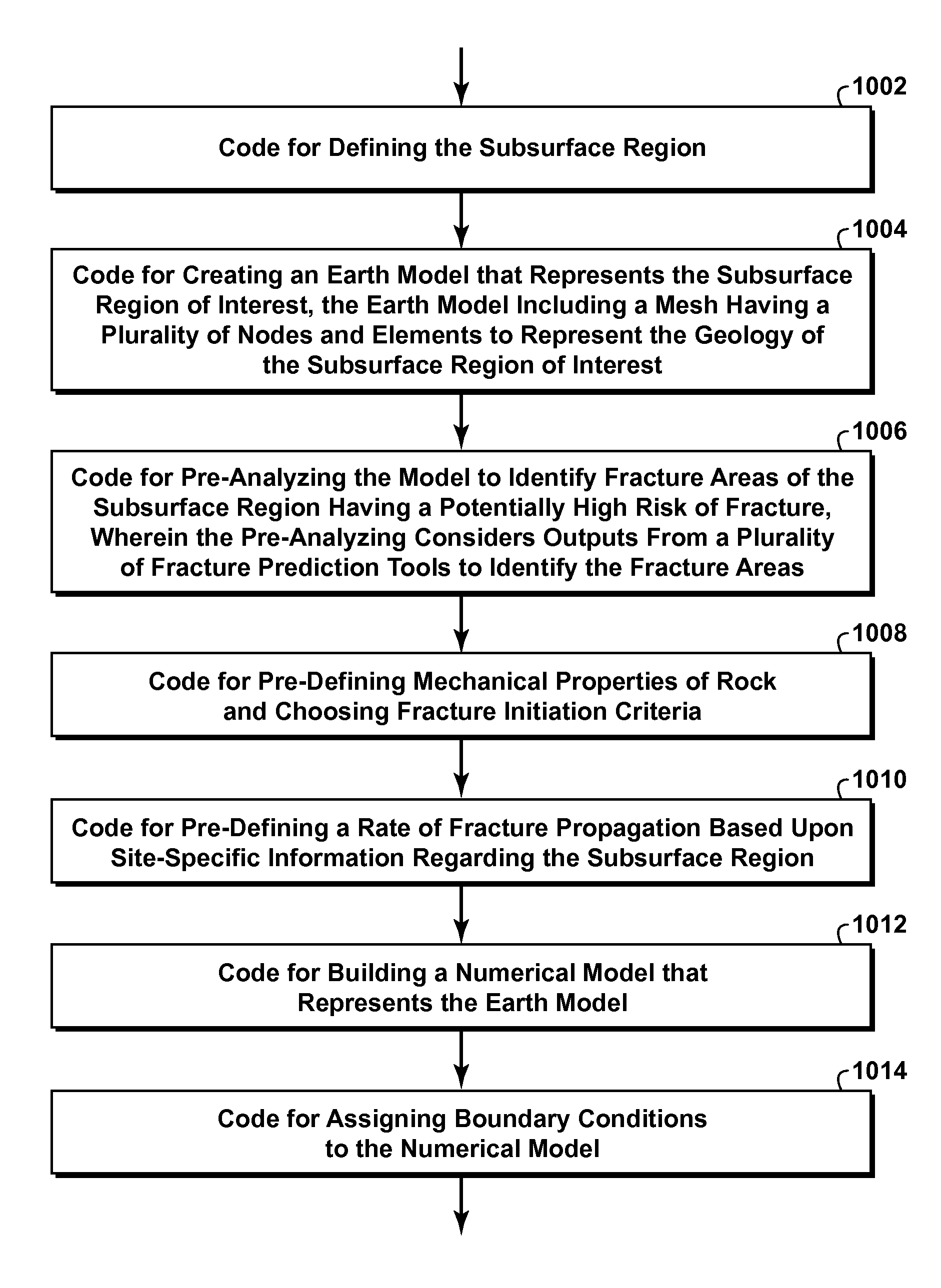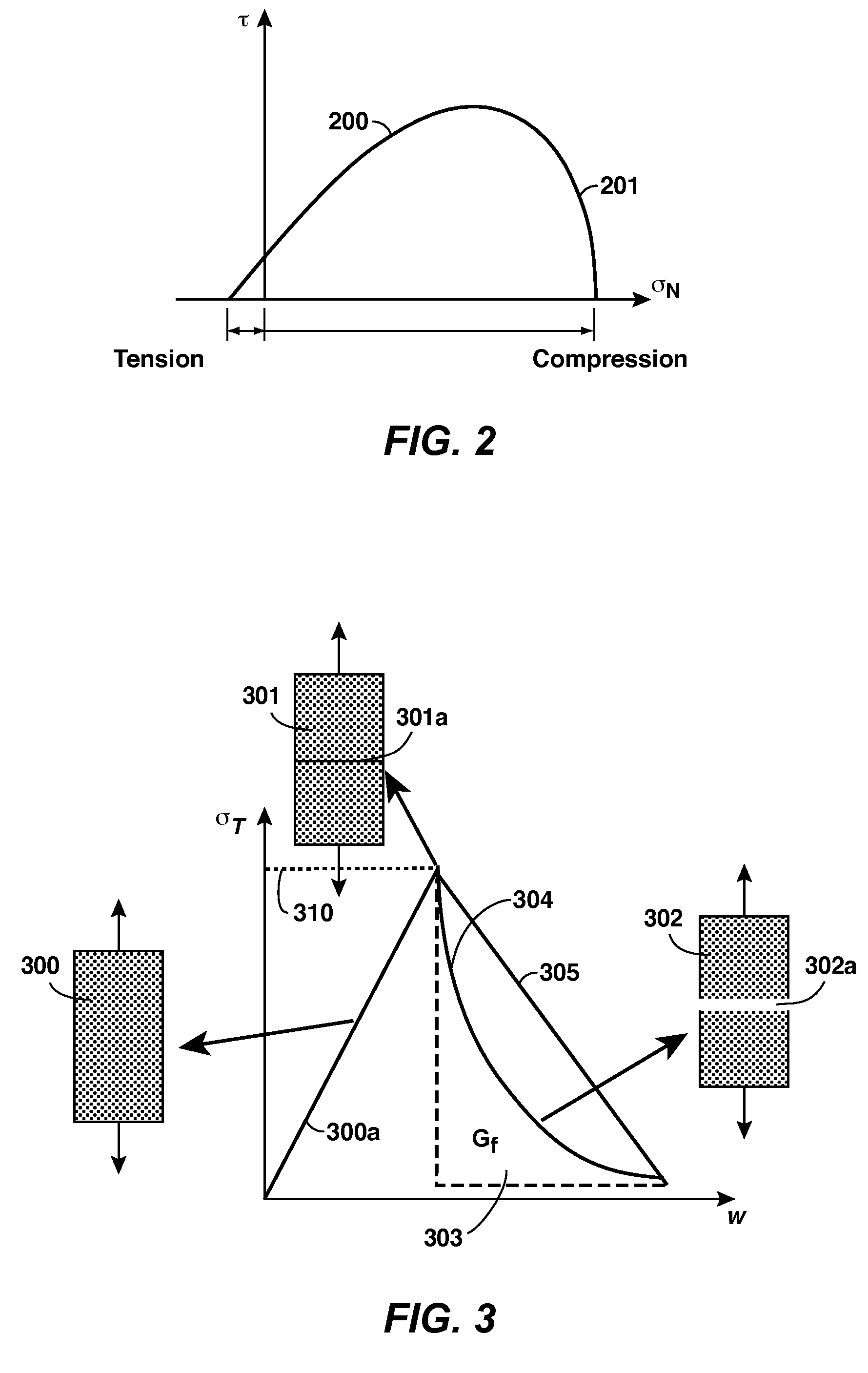However, in fields where subsurface data are limited, or in the early stages of exploration, fracture characteristics are usually predicted from 2D or 3D restoration or curvature analyses which have limited power for fracture prediction.
However, continuum models are unable to realize true
material separation, ultimately exhibiting regions of zero strength and effectively eliminating meaningful post failure interaction, which may include predicting multiple sets of fractures.
In this sense, the principal problem with continuum models is that the
resultant models are “too stiff” when no a priori knowledge of
crack initiation or distribution is available.
Although modeling fractures in rock masses may be of practical importance, this problem is among the most difficult to solve because fracture state evolves continuously and is not known a priori.
Furthermore, parts of closed fractures may begin to slip and later stick and initiate additional discrete fracture sets such as splaying or wing fractures.
Analytical Methods: The use of analytical methods based on linear elastic
fracture mechanics for fracture prediction (due to single or multiple preexisting fractures) (Horii and Nemat-Nasser (1986)) is difficult and arduous (Schlangen and Garboczi (1997)).
For example, none of the aforementioned analytical techniques can take into account post fracture interaction, sequential fracturing, advanced constitutive models, material failure and complex layering.
Furthermore, most of these solutions are derived under absolute tension which is rarely the case in nature.
However, this approach also suffers from the limitations of the aforementioned analytical solutions: it has limited
predictive power for identifying
natural fracture characteristics such as intensity, spacing and
connectivity and damage localization.
The results of these tests are inconsistent.
Therefore, unless additional kinematic and mechanical constraints are introduced, curvature based fracture predictions remain problematic.
The restoration techniques mentioned above are inadequate due to the following reasons: it is uncertain which geometric restoration
algorithm should be used to model rock deformation (Hauge and Gray (1996); Bulnes and McClay (1999); Maerten and Maerten (2006)); they are not based on the fundamental principles of the conservation of
mass; no rock mechanical properties are incorporated in the models; mechanical interaction among faults and fractures is not considered; and only strain rather than stress is calculated as a proxy for fracture predictions.
Although mechanical restorations provide a significant uplift compared to geometric and kinematic restorations, fracture predictions are usually diffuse because they use a continuum approach with no failure.
As a summary the major pitfalls of mechanical restoration analysis can be listed as follows: fracture predictions are limited to continuum-elastic analyses (i.e. no tensile failure criterion is implemented) thus leading to unrealistic stress concentrations and diffuse deformations and the analyses are only applicable to folded and faulted regions.
Consequently they cannot take
advantage of the constraints imposed by physical laws to predict the orientations and the location of these geological features (Maerten and Maerten (2006)).
This becomes especially problematic when fractures are populated using statistical rules that are based on limited or poor
field data.
Predictions solely depend on a combination of experience, available in-situ fracture data and statistical assumptions, hence limiting the predictive capabilities of this approach significantly.
These models stay qualitative because of the limitations of large scale models and continuum approximation of fracture occurrence.
In these simulations failure is associated with plastic deformation.
This approach is not entirely correct for Mode-I brittle failure where fractures initiate predominantly under tension rather than shear.
To summarize the major limitations of current continuum modeling attempts for
natural fracture prediction: (a) continuum models do not allow modeling of individual fractures; (b) continuum models are better suited for predicting shear localization or activation of preexisting discontinuities rather than
initiation of Mode-I, opening type deformation; (c) the possibility of post failure fracture interaction and coalescence is ignored, thus prediction of multiple sets is difficult or rather erroneous; and (d) all natural fracturing in quasi-brittle rock is associated with extensional deformation and parting of material planes.
The current limitation of Distinct Element based codes for natural fracture simulations is related to the high number of particles necessary for
discretization even for small-scale problems.
However, spring constants cannot be extracted directly from conventional lab tests: they are
scale dependent and remain artificial parameters without extensive calibration against experimental observations.
This limits the applicability of this tool for naturally occurring fractures where a number of different geologically plausible scenarios exist.
This creates another challenge for analyzing fracturing process using DDM: what happens in the fracture tips in rocks still remains to be adequately understood.
There are no known current applications of large-scale or small-scale XFEM for natural fracture prediction.
Thus applications are limited to
simulation of a single or few large fractures.
However, at present lattice models do not seem well suited for modeling compressive
rock failure.
In general this application suffers from the same pitfalls of earlier lattice models.
First, the lattice model does not incorporate advanced constitutive models and plastic deformation.
Second, the model simulates fractures due to opening along a predefined plane of weaknesses under local tension.
However, this is rarely the case in nature where in most cases rock is subjected to overall compression.
Third, the model does not incorporate discrete layering and contact along newly created fracture surfaces.
In other words, fractures remain open as broken bonds remain repulsive.
Once a critical
shear stress is reached, slip occurs and new sets of fractures are created in the form of wing cracks.
Without well-established contact and friction algorithms, applications are strictly limited to extensional settings.
In nature, however, faulting and fracturing occur simultaneously.
That is, small scale fractures coalesce and form large scale faults.
Likewise,
fault propagation might also promote fractures in the vicinity of fault tips.
Sixth, the method does not address post fracture interaction and fracture saturation.
Lastly, elastic constants used in the spring lattice models are not based on experimental results and remain artificial parameters.
Existing methods are not suitable for predicting fracture occurrence under general loading and boundary conditions.
Due to the nature of unstable propagation and simultaneous failure in these settings, discrete fracture characteristics such as spacing and intensity can no longer be extracted from such models.
 Login to View More
Login to View More  Login to View More
Login to View More 


